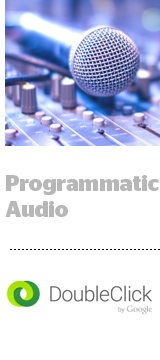
The potential of programmatic audio has caught the interest of advertising’s behemoth.
Google said Wednesday it had launched the ability to buy programmatic audio ads through its demand-side platform (DSP) DoubleClick Bid Manager.
Programmatic audio is still a new market, but it’s growing quickly.
Spotify launched the capability in 2016, and on its Q1 2018 earnings call, said its programmatic business grew 94% year over year. Pandora bought programmatic audio platform AdsWizz in March to build a programmatic marketplace for the industry. SoundCloud has a programmatic sales capability, as does radio streaming giant iHeartRadio.
On the buy side, DSPs like The Trade Desk and AppNexus launched programmatic audio capabilities in 2016 when Spotify started selling. Now Google wants in on the action.
“About a quarter of user time spent on mobile is spent listening to music and podcasts,” said Payam Shodjai, director of project management at DoubleClick (DBM). “Marketers want to reach their audiences wherever they are. We think audio is a part of that story.”
DBM’s programmatic audio solution is integrated with supply from Google Play Music, Spotify SoundCloud and podcast publisher TuneIn. Google also is integrating Pandora, Shodjai said. The platform won’t have access to YouTube inventory or any relationship with the recently launched subscription service YouTube Music.
Google began testing programmatic audio in January with 30 advertisers before bringing it out of beta. For now, it will execute audio buys through direct and guaranteed deals because the audio industry hasn’t yet warmed up to auction-based buying.
But the open exchange isn’t too far off, Shodjai said.
“The auction will very likely come in the coming quarters,” he said. “We’re working on it. We have to make sure the right supply is available. There’s a little bit of education required on both sides, but it’s just a matter of time.”
Through DBM, advertisers will be able to target audiences with audio ads by demo, context, language or geography. For now, audio buyers won’t get to overlay any proprietary data from within Google’s ecosystem.
Buyers using DBM for audio ads will be able to view and measure inventory alongside their display, video and other programmatic buys in the platform, Shodjai said. Because DBM is leveraging the IAB’s VAST 4.0 standard for delivery, it will be able to glean insights for reporting and measurement that are similar in video, like when a user hits certain points in an audio file or presses mute.
“All of that data appears in the same interface that an advertiser uses to buy all of their other digital ads,” he said.
Buyers will be able to pull general reports from DBM about how their audio ads are performing but will need to access Google’s measurement environment, Ads Data Hub, to manipulate the data or do cross-platform reporting, Shodjai said.
“You can do some comparison directly in the UI,” he said. “If you want to see audio CPMs versus video CPMs, you can get some of that basic stuff. If you want to do custom slicing and dicing and overlay that with some Google data, you go to Ads Data Hub.”
The decision to launch programmatic audio now really comes down to “sequencing priorities,” Shodjai said.
“We’ve been focusing very heavily on our video and TV efforts,” he said. “Now that more audio supply is available, we decided to bring that channel into DBM.”
While Google recognizes the opportunity in programmatic audio is growing, it knows the market is still nascent and needs some education.
“It’s still early days for audio ads in general,” Shodjai said, “But the demand is definitely there. Now, it’s really just a question of showing them the breadth of inventory available.”
This post was syndicated from Ad Exchanger.

More Stories
Island Gelato partners with Impact PR
Meta More Than Doubled Revenue From its AI-Powered Ad Tool
How A Digital Media Agency Built Its Own AI-Powered Contextual Targeting Tool